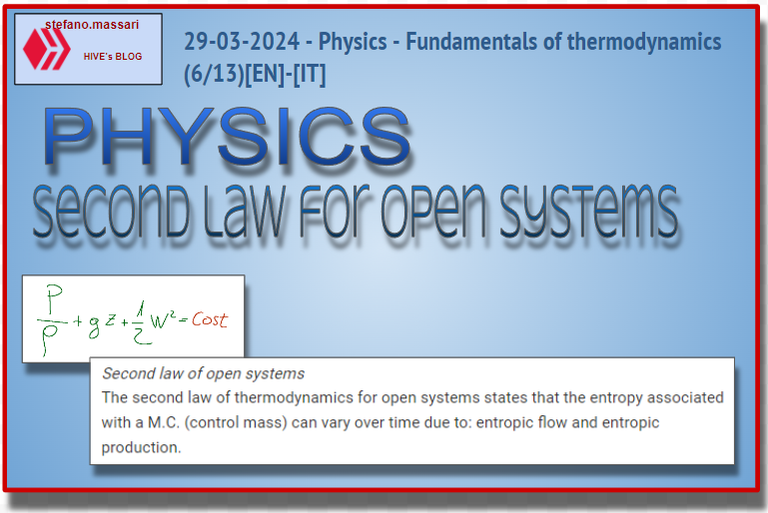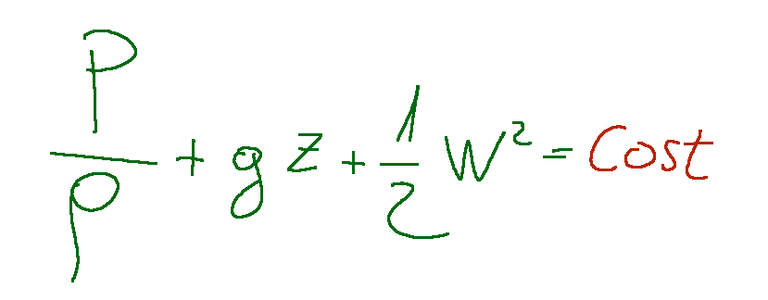29-03-2024 - Fisica - Fondamenti di termodinamica (6/13)[EN]-[IT]

~~~ La versione in italiano inizia subito dopo la versione in inglese ~~~
ENGLISH
29-03-2024 - Physics - Fundamentals of thermodynamics (6/13)[EN]-[IT]
Second law for open systems
Second law of thermodynamics for open systems
First law of open systems
The first law of thermodynamics for open systems states that the energy associated with a M.C. (control mass) can vary over time due to two different types of energy flows: thermal power and mechanical power.
Second law of open systems
The second law of thermodynamics for open systems states that the entropy associated with a M.C. (control mass) can vary over time due to: entropic flow and entropic production.
Mechanical Energy Equation
The formula
Below is the mechanical energy equation

NOTE:
Mechanical energy is also seen as the sum of kinetic energy and potential energy.
Coincidence
This formula coincides with the Bernoulli equation, relating to the motion of a non-viscous fluid in stationary cases, with a single inlet and a single outlet, in the absence of propeller work and friction.
Load loss
Definition
The pressure drop is defined as the difference between the extreme sections of a pipe of length L.
NOTE:
The statement of the Bernoulli equation is the following.
In this equation there are three contributions and the sum of these remains constant throughout the path of the duct.
The three contributions are the following:
-Fluid pressure (P)
-product of its density for the acceleration of gravity and for the altitude (ρgh)
-half the product of the fluid density and the velocity squared (1/2 * ρ * V2)
Below is the complete formula:

differential operators
Gradient and divergence
In thermodynamics the most used differential operators are gradient and divergence.
The gradient of a variable, such as temperature T, is an operator that transforms a scalar into a vector. Instead, the divergence of a vector, on the contrary, is an operator that transforms a vector into a scalar.
NOTE:
The management
What is management
Conduction refers to one of the modes of heat transmission between solids.
Thermal conductivity
K is the thermal conductivity of a material and is linked to the production of entropy, it is measured in W/m°K
Conclusions
The mechanical energy equation coincides with the Bernoulli equation relating to the motion of a fluid. However, this is if we mean a non-viscous fluid and in the absence of propeller work and friction.
Request
Have you heard of Bernoulli in the past? Have you studied any of his formulas?

29-03-2024 - Fisica - Fondamenti di termodinamica (6/13)[EN]-[IT]
Seconda legge per i sistemi aperti
Seconda legge della termodinamica per i sistemi aperti
Prima legge dei sistemi aperti
La prima legge della termodinamica per i sistemi aperti stabilisce che l'energia associata ad una M.C. (massa di controllo) può variare nel tempo a causa di due differenti tipi di flussi energetici: potenza termica e potenza meccanica.
Seconda legge dei sistemi aperti
La seconda legge della termodinamica per i sistemi aperti stabilisce che l'entropia associata ad una M.C. (massa di controllo) può variare nel tempo a causa: del flusso entropico e della produzione entropica.
Equazione dell’energia meccanica
La formula
Qui di seguito l'equazione dell'energia meccanica

NOTA:
L'energia meccanica è vista anche come la somma dell'energia cinetica e dell'energia potenziale.
Coincidenza
Questa formula coincide con l'equazione di Bernoulli, relativa al moto di un fluido non viscoso nei casi stazionari, con un solo ingresso ed una sola uscita, in assenza di lavoro d'elica e di attriti.
La perdita di carico
Definizione
La perdita di carico si definisce come la differenza tra le sezioni estreme di una condotta di lunghezza L.
NOTA:
L'enunciato della equazione di Bernoulli è il seguente.
In questa equazione ci sono tre contributi e la somma di questi si mantiene costante tutto lungo il percorso del condotto.
I tre contributi sono i seguenti:
-Pressione del fluido (P)
-prodotto tra la sua densità per l'accelerazione di gravità e per la quota (ρgh)
-metà del prodotto della densità del fluido per la velocità al quadrato (1/2 * ρ * V2)
Qui di seguito la formula completa:

operatori differenziali
Gradiente e divergenza
In termodinamica gli operatori differenziali più usati sono il gradiente e la divergenza.
Il gradiente di una variabile, ad esempio la temperatura T, è un operatore che trasforma uno scalare in un vettore. Invece la divergenza di un vettore, al contrario, è un operatore che trasforma un vettore in uno scalare.
NOTA:
La conduzione
Cosa è la conduzione
Per conduzione si intende una delle modalità di trasmissione del calore tra solidi.
La conducibilità termica
K è la conducibilità termica di un materiale ed è legata alla produzione di entropia, si misura in W/m°K
Conclusioni
L'equazione dell'energia meccanica coincide con l'equazione di Bernoulli relativa al moto di un fluido. Questo però se si intende un fluido non viscoso ed in assenza di lavoro d'elica e di attriti.
Domanda
Avete sentito parlare in passato di Bernoulli? Avete studiato qualche sua formula?
THE END
The problem I usually have with thermodynamics is the formula
I always find it difficult to assimilate it. Thanks for the lecture
The second law for thermodynamics is something incredible and I will rewrite it at the bottom of this comment. To write it I have to have it before my eyes because I can't even remember it by heart. But first let's remember the most important thing established by the second law of thermodynamics of open systems. The entropy of a C.M., control mass, can vary over time due to entropic flow and entropic production. And now I bring you the formula that represents the second law of thermodynamics for open systems.
Mechanical energy is the term that goes a long way in establishing some concept
No, queste formule sono più di ingegneria meccanica
Hai perfettamente ragione, anche secondo me queste sono cose studiate maggiormente dagli ingegneri meccanici. Ad esempio gli operatori differenziali sono operatori che vengono studiati proprio in ingegneria. Operatori differenziali come il gradiente e la divergenza non si studiano spesso a scuola. Ripeto qui di seguito il loro concetto. Il gradiente di una variabile, ad esempio la temperatura T, è u operatore che trasforma uno scalare in un vettore, la divergenza di un vettore è il suo opposto, è un operatore che trasforma un vettore in uno scalare.
Thank you so much for explaining this well detailed even though at first it was looking quite complicated but I do understand